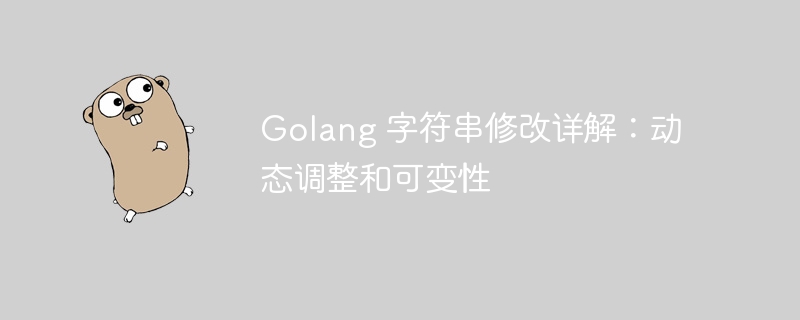Home >Backend Development >Golang >Detailed explanation of Golang string modification: dynamic adjustment and variability
Detailed explanation of Golang string modification: dynamic adjustment and variability
- PHPzOriginal
- 2024-04-08 15:27:011147browse
Strings in GoLang, although immutable, can be dynamically modified through the following techniques: concatenating strings using string concatenation. Create a new string using string formatting. Modify the underlying byte slice of the string. Use mutable string types provided by third-party libraries.

Detailed explanation of GoLang string modification: dynamic adjustment and variability
Introduction
In GoLang, strings are immutable, which means that they cannot be modified after they are created. However, we can dynamically adjust the content of the string through various technologies to achieve the string modification function. This article will explore common techniques for string modification in GoLang and provide practical cases to demonstrate its application.
1. Use string concatenators
The easiest way is to use string concatenators (" ") to connect one string to another string . For example:
str1 := "Hello" str2 := "World" str3 := str1 + " " + str2 fmt.Println(str3) // 输出: Hello World
2. Using string formatting
We can use the fmt.Sprintf() function to format the string and create new string. fmt.Sprintf()Can accept a format string and any number of parameters, and return the formatted string. For example:
name := "John"
age := 30
bio := fmt.Sprintf("My name is %s and I am %d years old.", name, age)
fmt.Println(bio) // 输出: My name is John and I am 30 years old.3. Using byte slices
Strings in GoLang are essentially byte slices. This means that we can directly modify the underlying byte array of the string to modify the content of the string. For example:
str := "Hello World" bytes := []byte(str) bytes[0] = 'G' str = string(bytes) fmt.Println(str) // 输出: Gello World
4. Using third-party libraries
There are some third-party libraries that provide additional string modification functions. For example, the github.com/google/go-stringutil library provides a MutableString type that allows us to modify the content of a string.
import "github.com/google/go-stringutil"
mstr := gostringutil.NewMutableString("Hello World")
mstr.Replace("World", "Universe")
fmt.Println(mstr.String()) // 输出: Hello UniversePractical case: Constructing a string buffer
The following is a practical case using string concatenation to construct a string buffer:
func buildBuffer(size int) string {
buffer := ""
for i := 0; i < size; i++ {
buffer += fmt.Sprintf("%d", i)
}
return buffer
}This function can dynamically generate a string of specified size, containing integers from 0 to size-1.
Conclusion
The dynamic adjustment and variability of strings in GoLang can achieve a variety of string modification needs. This article covers common techniques for using string concatenation, string formatting, byte slicing, and third-party libraries. By skillfully applying these techniques, we can easily handle string modification tasks and improve the efficiency and flexibility of GoLang code.
The above is the detailed content of Detailed explanation of Golang string modification: dynamic adjustment and variability. For more information, please follow other related articles on the PHP Chinese website!

